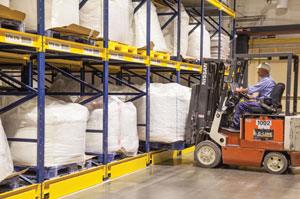 |
| This General Mills plant switched from 25-lb. bags of ingredients to 2,500-lb. super sacks to enhance efficiency and material handling. Steel King SK 3400 flow storage and SK 3600 pushback rack systems ease the flow. Source: Steel King. |
General Mills’ Cedar Rapids, IA plant had successfully used pallet flow and pushback rack systems, but ongoing growth, product changes and long usage time created the need for a storage system that would safely add capacity to its existing facility.
The plant’s previous pallet flow and pushback rack systems had been in use for almost 15 years. During that time, volumes had grown, pallets had become heavier, and a switch (where possible) from 50-lb. bags of ingredients to 2,500-lb. bulk super sacks was made to enhance efficiency and minimize material handling, according to Scott Ladwig, an inventory analyst at the plant.
“The challenge was to make better use of our existing vertical warehouse space, since adding to our building was not an option,” says Ladwig, who sought to avoid trailers of inventory sitting in the yard or contracted third-party storage. “We wanted to safely optimize our storage, inventory and production.”
Ladwig turned to RMH Systems, a material handling equipment distributor, and Steel King, a manufacturer of flow storage systems and pallet racks. After consulting with General Mills and Steel King engineers, RMH Systems recommended, and the plant implemented, Steel King SK 3400 flow storage and SK 3600 pushback rack systems.
In a flow storage system, dynamic flow rails are inclined in a static rack structure, allowing loads placed on one end to move by gravity on rollers to the unloading end, with speed controllers acting as gentle brakes. As a load is removed, the loads behind it move forward automatically.
Since the flow system depth, height and width are limited only by the size of the facility and capabilities of the material handling equipment, it was a good fit for the plant’s high-volume, space-efficiency needs. Once product is loaded, FIFO rotation is automatic. The rack eliminates labor and fork truck operation to arrange loads; forklifts are required only for the initial and final unloading. Since only two aisles are necessary, aisle space can be reduced by 75 percent, and up to 100 percent more product can be stored than with traditional selective pallet racking.
A pushback pallet rack system offers up to 90 percent more product storage than selective rack systems and up to 400 percent more selectivity than drive-in racks. Unlike static, single-pallet deep selective racks, a dynamic pushback rack system allows storing pallets two to five deep while providing easy access to a variety of different SKUs.
“Integrating the two separate racks into one rack system has increased storage capacity by 42 percent and freed up space, allowing the addition of 24 percent more inventory items,” says Ladwig. “It also has eliminated any issue of trailers of inventory sitting in the yard and the potential need for contracted third-party storage space.”
For more information: Kelly Kubisiak, 800-826-0203, kkubisiak@steelking.com, www.steelking.com



